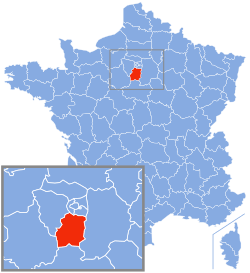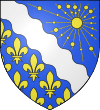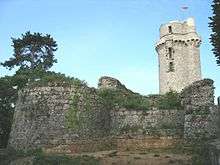Essonne
| Essonne | |||
|---|---|---|---|
| Department | |||
|
Prefecture building of the Essonne department, in Évry | |||
| |||
 Location of Essonne in France | |||
| Coordinates: 48°30′N 02°17′E / 48.500°N 2.283°ECoordinates: 48°30′N 02°17′E / 48.500°N 2.283°E | |||
| Country | France | ||
| Region | Île-de-France | ||
| Prefecture | Évry | ||
| Subprefectures |
Étampes Palaiseau | ||
| Government | |||
| • President of the General Council | François Durovray (LR) | ||
| Area1 | |||
| • Total | 1,804 km2 (697 sq mi) | ||
| Population (2013) | |||
| • Total | 1,253,931 | ||
| • Rank | 15th | ||
| • Density | 700/km2 (1,800/sq mi) | ||
| Time zone | UTC+1 (CET) | ||
| • Summer (DST) | UTC+2 (CEST) | ||
| Department number | 91 | ||
| Arrondissements | 3 | ||
| Cantons | 21 | ||
| Communes | 196 | ||
| ^1 French Land Register data, which exclude estuaries, and lakes, ponds, and glaciers larger than 1 km2 | |||
Essonne (pronounced [ɛsɔn]) is a French department in the region of Île-de-France. It is named after the Essonne River.
It was formed on 1 January 1968 when Seine-et-Oise was split into smaller departments.
History
The Essonne department was created on 1 January 1968, from the southern portion of the former department of Seine-et-Oise.
In June 1963 Carrefour S.A. opened the first hypermarket in the Paris region at Sainte-Geneviève-des-Bois (although the word "hypermarché" was first used only in 1966). Based on the ideas put forward by the American logistics pioneer Bernardo Trujillo,[1] the centre offered on a single 2,500 m2 (26,909.78 sq ft) site a hitherto unknown combination of wide choice and low prices, supported by 400 car parking spaces.
In 1969, the communes of Châteaufort and Toussus-le-Noble were separated from Essonne and added to the department of Yvelines.
Geography
Essonne belongs to the region of Île-de-France.
It has borders with the departments of:
- Hauts-de-Seine and Val-de-Marne to the north,
- Seine-et-Marne to the east,
- Loiret to the south,
- Eure-et-Loir and Yvelines to the west.
All of northern Essonne department belongs to the Parisian agglomeration and is very urbanized. The south remains rural.
In descending order, the cities over 25,000 population are: Évry, Corbeil-Essonnes, Massy, Savigny-sur-Orge, Sainte-Geneviève-des-Bois, Viry-Châtillon, Athis-Mons, Palaiseau, Draveil, Yerres, Les Ulis, and Vigneux-sur-Seine. Milly-la-Forêt is an example of its more rural communes.
Main sights
- L'École Polytechnique. Founded in 1794, L'Ecole Polytechnique is one of the most prestigious engineering universities in France. This university was ranked 10th in the world by the Times Higher Education Supplement in 2005. Its campus is in the town of Palaiseau.
- Université de Paris-Sud. One of the best public schools in France, it is ranked 52nd by Academic Ranking of World Universities. It is best known for its physics department. Located in Orsay, Essonne, about 26,000 students are enrolled.
- The Headquarters of the Arianespace Company, a major commercial aerospace launcher, servicing companies who wish to launch satellites into space.
- Château de Montlhéry. Originally having been an ancient fort during Roman times, the first feudal lords began to inhabit the castle around 1000 AD. One major battle was fought in the castle during its lifetime. In 1465, Charles the Rash and French King Louis XI fought in the plains in front of the castle. In 1842, the reconstruction of the castle was started, and currently is being maintained by the local town of Montlhery
- Château de Courances
- The Forest of Sénart. Covering 3,500 hectares in area, this forest is very important to the local population. The local government has kept roads and agricultural companies from cutting down parts of this forest. The forest receives between two and three million visitors annually, and the government spends 1.2 million euros a year maintaining it.
- Telecom Sudparis. Situated in Évry, this is a grande école for engineers
Politics
The department's most high-profile political representative has been Manuel Valls, Prime Minister of France from 31 March 2014 to 6 December 2016. He visited its main town Évry to deliver remarks following the Charlie Hebdo massacre of January 2015.
Demographics
Place of birth of residents
| |||||||||||||||||||
Tourism
See also
References
External links
- (in French) Prefecture website
- (in French) General council website
- Flickr Photography Group for Essonne region
- Anglo Essonne




